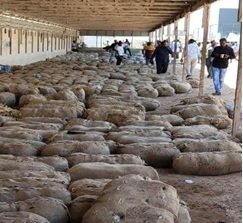By Abdinur Jama (Gees)
Kenya’s recent decision to double the price of Miraa (Khat) has sent shockwaves through Somalia’s already fragile economy. This policy change not only exposes the shortcomings in trade strategies and economic priorities but also lays bare the political elite’s complicity in sustaining an unsustainable dependency. For decades, Somalia has been one of the largest consumers of Kenyan Miraa—channeling hundreds of millions of dollars every year into a product that yields little economic benefit, fuels addiction, and depletes our scarce foreign reserves.
An analysis by the International Monetary Fund (IMF) warns that such non-essential imports are undermining economic stability in fragile nations like Somalia. As noted in the IMF report, reliance on imported consumer goods—especially those that do not spur productive investment—deepens vulnerabilities and erodes the nation’s capacity for sustainable growth.
A Billion-Dollar Dependency: How Did We Get Here?
Somalia imports roughly 50 tonnes of Kenyan Miraa every day. In 2023, with prices at around $23 per kilogram, this meant a daily spend of about $1.1 million—totaling nearly $420 million a year. With Kenya now doubling its prices, Somalia’s annual outlay could soar to almost $1 billion.
This massive expenditure not only drains national reserves but also hits household incomes hard. As traders pass on higher costs to consumers, families must spend more on Miraa, leaving less for essentials like food, education, and healthcare. This diversion of funds deepens inflation, stifles domestic growth, and further entrenches poverty—an economic gamble that jeopardizes the future of a nation already struggling with fiscal instability.
Trade Imbalance, Smuggling, and Political Neglect
Somalia’s trade relationship with Kenya has long been deeply asymmetrical. While Kenya benefits from a steady inflow of revenue from Miraa exports, Somalia sends virtually nothing back. This has created a severe trade imbalance, continuously draining our foreign currency reserves.
Adding to this crisis is the rampant smuggling of Miraa across unregulated border crossings, particularly in the regions adjacent to Kenya. As reported by Nation Africa, local opposition to this exploitative trade has reached a fever pitch—with a boycott of Miraa exports to Somalia. This boycott is a stark signal of growing discontent among Kenyan traders and local authorities, who are fed up with the exploitative trade practices that benefit a few at the expense of many.

The illicit flow of Miraa means that, despite the enormous profits accruing to Kenyan farmers and traders, the Somali government collects no tax revenue from these transactions. This loss of potential income further cripples our ability to finance essential public services, worsening the plight of ordinary Somalis. Meanwhile, many of our own political leaders are more interested in securing personal Miraa import contracts than in protecting national economic interests—a betrayal that undermines public trust and deepens our dependency.
The Political Economy of Miraa: Who Benefits?
The Miraa trade is far more than a commercial transaction—it is a highly politicized arena. Successive Kenyan administrations have actively lobbied to preserve and even expand Somalia’s dependence on their Miraa exports, leveraging diplomatic channels to maintain a lucrative monopoly over the Somali market. Most of the local Kenyan reports underscore how Kenyan traders have exploited this dependency to widen their market share even as Somalia’s consumption increases.
On the Somali side, a network of importers, brokers, and politicians thrives on this arrangement through preferential contracts, kickbacks, and clandestine deals. These actors have little incentive to challenge the status quo since the continued flood of Miraa guarantees their personal enrichment. Moreover, as this is symptomatic of a broader pattern of repression, corruption, and political betrayal—a pattern where national interests are sacrificed at the altar of personal gain.
Adding insult to injury, Kenya has eased travel requirements for nearly all African visitors—except for Somalia and Libya. Despite being our neighbor and a recent member of the IEC, Somalia is unfairly marginalized in regional policy, forced to import Kenyan Miraa under draconian conditions. This discriminatory practice not only cements Kenya’s economic stranglehold over the Miraa trade but also highlights the political double standards that continue to undermine Somalia’s sovereignty.
A National Wake-Up Call: What Must Be Done?
Kenya’s decision to double Miraa prices must serve as a clarion call for urgent, decisive action from Somalia’s leadership and citizens. To halt this economic hemorrhage, we must adopt a multi-pronged strategy:
- Boycott Overpriced Kenyan Miraa: The Somali government must put an end to this imbalanced trade. I reject proposals to raise import tariffs, as such measures would only burden Somali households—Miraa traders would simply pass the increased costs onto consumers, exacerbating inflation.
- Strengthen Ethiopian Trade Relations: Ethiopia is another major producer of Khat, and Somalia must diversify its supply chains to reduce dependence on Kenya. Ethiopia may offer more favorable trade terms, allowing for fair barter trade where Somalia exports fish in exchange for Khat, thus reducing trade imbalances.
- Hold Politicians Accountable: Somali politicians must be held to account. Somali politicians must be pressured to prioritize national interests over personal enrichment. The public should demand transparency in Miraa trade agreements and ensure that officials benefiting from corrupt deals are exposed.
- Public Awareness: Somali citizens must be educated about the economic consequences of Miraa consumption. A nationwide campaign should highlight how every dollar spent on Miraa is a dollar lost for Somalia’s development.
The Cost of Inaction
If Somalia continues down this perilous path of unchecked Miraa imports, it risks deepening its economic vulnerabilities, exacerbating trade imbalances, and cementing its dependence on external actors. A nation that expends nearly a billion dollars on an imported narcotic while its roads, schools, and hospitals languish is on a trajectory toward self-destruction.
The choice is clear: Either Somalia must take bold, corrective steps to reduce its reliance on Kenyan Miraa, or it will remain trapped in a cycle of economic exploitation, political corruption, and financial irresponsibility. The time for decisive action is now.
Abdinur Jama (Gees)
Email: abdinour2014@gmail.com


Leave a Reply